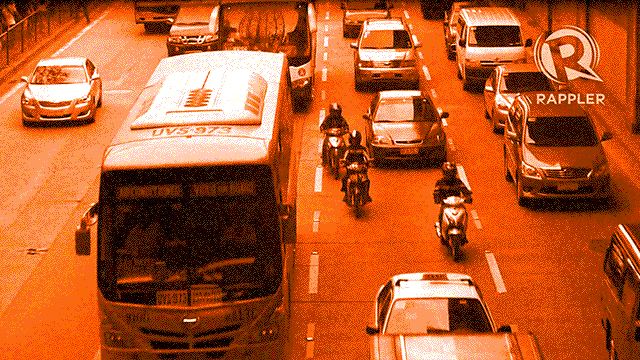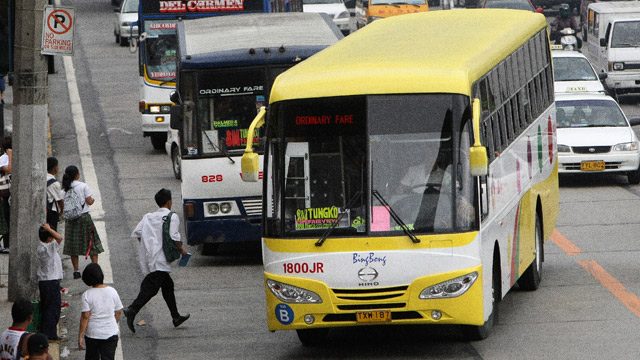SUMMARY
This is AI generated summarization, which may have errors. For context, always refer to the full article.

MANILA, Philippines – The commuter jeepney is considered by many to be the king of Filipino roads. But the busy streets of Metro Manila’s EDSA has become the kingdom of another kind of vehicle – the city bus.
“[In the past], it was the parang sachet mentality, tingi-tingi (piecemeal). The [bus] operator would come to us: [for example] I want Lawton to Alabang. The department would analyze it based on that application. Hindi siya (It’s not a) network,” said Booey Bonifacio, Department of Transportation and Communication (DOTC) assistant secretary for planning and finance.
The result? Too many bus lines or franchises plying the same routes, competing over a limited number of commuters. It’s a behavior that has resulted in several high-profile crashes this year alone. (READ: Road accidents? Let’s call them crashes)
Early this year 18 people died on-site after a Don Mariano city bus fell off the Skyway on the Southern Luzon Expressway. The Don Mariano franchise was later cancelled for neglecting to ensure safety in its operations.
Illegal buses
Bonifacio says the “boundary system” is partly to blame. Foreign observers, she said, are in agreement when analyzing the system which requires drivers and conductors to pay operators a fixed amount daily.
The numbers, according to a report from the Philippine Daily Inquirer, are a little more promising. Of 214 bus companies in Metro Manila in 2013, 97 have already stopped using the “boundary system” and switched to a fixed payment scheme for its drivers and conductors.

But fixing the pay scheme of drivers and conductors can only do so much. Bonifacio says more important is making sense of how transportation in the metro should work.
The Land Transportation Franchising and Regulatory Board (LTFRB), which is under the DOTC, has imposed a moratorium on new city bus routes. “Kasi masyadong convoluted, nanganganak [ang franchises],” Bonfiacio said, alluding to “colurum” or illegal buses. (It’s too convoluted. And franchises end up giving birth to other franchises.)
Public utility buses are only allowed to ply specific routes once approved by the LTFRB. Bus units not included in route-specific franchises are considered “colorum.” (READ: Why the EDSA bus segregation system doesn’t work)
“Colorum” buses are one of the things that pushed the local government of Manila to impose a ban on buses without terminals inside the city in 2013. Vice Mayor Isko Moreno earlier estimated around 1000 buses traverse the city 3-4 times a day.
Bonifacio admits it’s difficult to even estimate how many “colorum” buses operate in the metro daily.
Power of data
A Metro Manila transportation study is set to be completed by July 2014. Bonifacio explained that for too long, both the national and local governments were giving out franchises, and allowing various modes of transportation to operate without looking at the bigger picture. (READ: DOTC eyes bus rapid transit, more walkways, car-less cities)
Bonifacio called the study a “game changer.”
The study will allow government to determine which modes of transportation fit specific areas the best, said Bonifacio. One example, he said, would be the planned Bus Rapid Transit from Quezon Avenue to Commonwealth Avenue. The demand is so high, she said, that it requires high-capacity modes of transportation instead of the traditional jeepneys.
The crack down on bus franchises and operators, at least within Metro Manila alone, will not be easy, DOCT spokesperson Migs Sagcal admitted. The DOTC’s introduction of a new license plate design has been met with staunch criticism.
But they say it’s one way to prevent “colorum” buses from ruling the metro’s major thoroughfares.
The future of buses
Future plans to modernize the metro’s buses include incorporating them into the Metro Rail Transit and Light Rail Transit’s single ticketing project. That way, said Bonifacio and Sagcal, bus operators will be obliged to give their drivers and operators a fixed salary, along non-financial benefits.
The DOTC and LTFRB will soon be requiring GPS devices and speed limiters in buses. Sagcal said requiring GPS devices allows the DOTC to collate data on commuter behaviors, at least for buses. In the long run, the very same data will be used to predict the kind of infrastructure needed to address increases in demand.
The GPS devices, said Sagcal, is the first step to creating a system similar to that of Singapore where commuters can access an app or website to monitor the comings and goings of buses – a far cry from the unpredictability of today’s city buses.
All the plans and and projects are part of the DOTC’s moves to “catch up” after lagging behind for so many years. “Singapore started with this what, 10 years ago? It should bring us to the same page eventually. All the projects are catching up, like 15-20 years back, but also planning for the next 10-15 years,” said Sagcal.
A “trigger mechanism” will also be in place to determine when and how the DOTC’s projects, especially those done in partnership with private companies, should expand in the future. The “trigger mechanism,” said Sagcal, is part of the deal to expand the Mactan Airport in Cebu.
“Previously, there’s no such thing. So today, we realize: Oh my god, I need a new runway. And you need to go through the same long processes. Before you know it, it’s an MRT 3 all over again,” he added. – Rappler.com
Add a comment
How does this make you feel?
There are no comments yet. Add your comment to start the conversation.